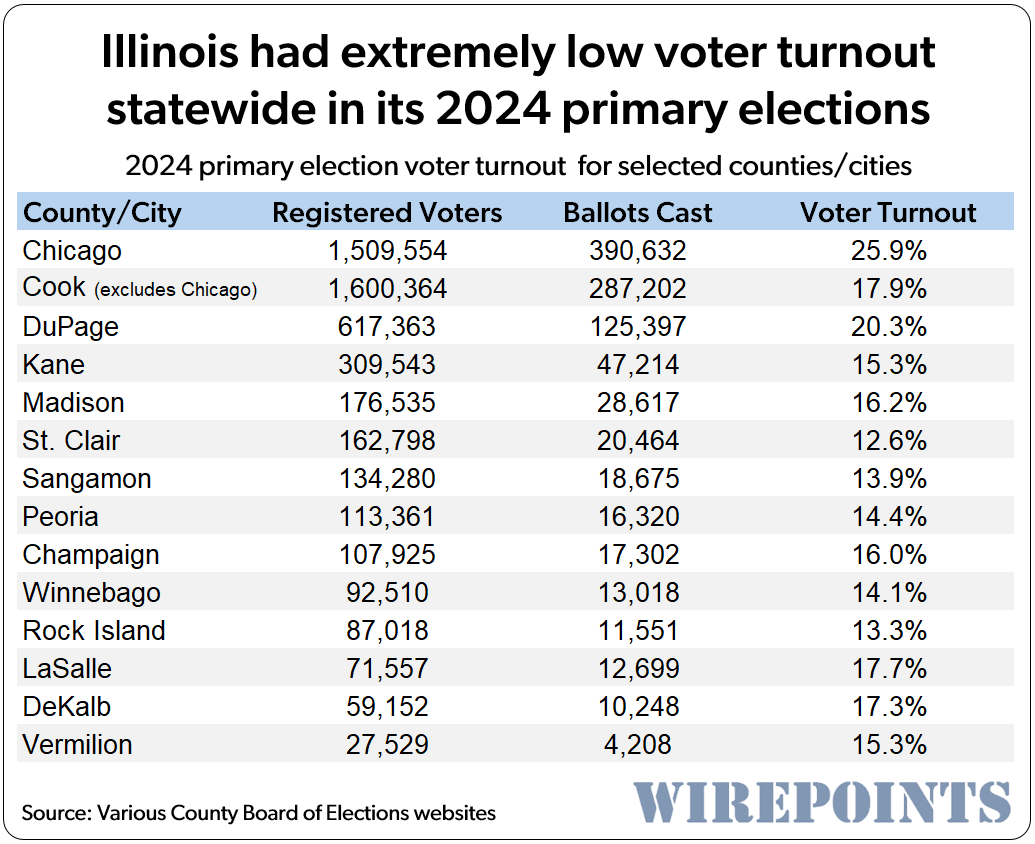Editor's note: This opinion article was originally published at Wirepoints.org.
Few Illinoisans found reason to vote in the most recent primary elections. Overall, voter turnout was maybe just 20 percent statewide. Perhaps it was a lack of competitive elections. Or gerrymandering. Or people think their votes don’t matter. Maybe it was a little bit of each.
Whatever it was, few seem to care. And that’s bad news for Illinois’ future. Rising crime, higher property taxes, increased corruption and more won’t go away if Illinoisans who want change stay away from the ballot box.
A look across the state shows how few people bothered to show up.
In Winnebago County, where Rockford is located, just 14 percent of registered voters cast a ballot. That was a pathetic 13,000 people. In Sangamon County, home of the state’s capital, it was only 13.9 percent. Just 19,000 voters showed up.
And in Chicago, where violent crime, illegal immigration, a potential tax hike and general disenchantment with Mayor Johnson gave people plenty of reason to show up and vote, turnout was just 25.9 percent.
Apathy prevailed even in the Cook County State’s Attorney’s race, where voters had an opportunity to categorically reject Clayton Harris, III, who was widely seen as the anointed successor to soft-on-crime incumbent Kim Foxx. Eileen O’Neill Burke barely eked out a victory.
Unfair maps help contribute to low turnout
Other factors contributed to a lack of voter turnout. For one, the lack of competition at the top of both tickets had an impact. The lack of statewide races such as governor or U.S. Senator factored in as well.
But another factor was a lack of choice. According to WTTW, 88 percent of primaries were uncontested in Illinois, the fewest in the past 20 years. Why show up if the only candidate on the ballot already won by default?
Lack of competition is one of the byproducts of gerrymandering. It serves to suppress competition. If a district leans too heavily either Republican or Democrat, the primary becomes the de facto election.
For example, take a very blue district where two Republicans run in a primary for the chance to unseat a Democrat in the general election. But that blue district has a long history of voting Democrat 80-20 in the general election. That Republican primary vote doesn’t even matter.
This lack of competition goes both ways. With Cook County Republicans having nothing substantial to vote for, many undoubtedly pulled a Democratic primary ballot to vote against Clayton Harris III. The more moderate Democratic candidate, Eileen O’Neill Burke, benefited from that crossover. In this case, gerrymandering – or lack of competition – hurt progressive voters.
There were a few exceptions. Some local bond or tax referendums motivated additional people to vote. Take Central School District 301’s ask for $195 million in bonds, which failed 64 to 36. Voter turnout for that referendum (35.5 percent) was more than double Kane County’s overall election turnout (15.3 percent).
It’s amazing that an anemic 35 percent turnout can be considered a high point for this primary.
What’s more amazing is this: Turnout is terrible even though Illinois politicians have made voting easier than ever. Early voting, curbside voting, vote-by-mail.
Ease of access means nothing when people think their votes don’t matter.

